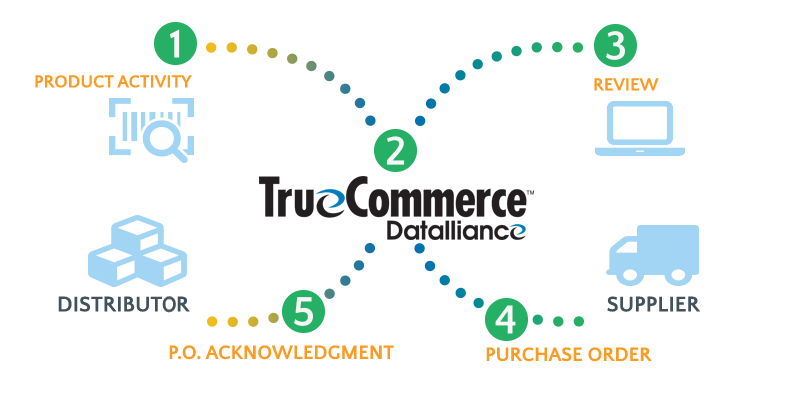Demand Forecasting Models for the Future Using Retailer Data

October 27, 2021
Supply chain businesses of all types are shifting away from using historical data as a single source of information for their demand forecasting models. In the past, suppliers based their order replenishment cadence to customers—such as large retailers—on raw sales and shipment data points harvested from the same time period the previous year. Sprinkled throughout that data mix might also be some expert best guesses for changes the new season could bring, based on market research.
In our data-driven world, however, both suppliers and leading-edge retailers recognize that this backwards view isn’t the most accurate or most lucrative way to predict future demand patterns. Advances in technology like vendor managed inventory (VMI) have given suppliers and customers the ability to share their information in deeper ways, and it makes sense to use these capabilities to the fullest.
Just as you wouldn’t keep your eye on the rear-view mirror if you want to drive a car forward with speed and accuracy, suppliers and retailers focused on higher sales and more efficient shipments are turning away last-century demand forecasting models. Instead, they are shifting toward harnessing the power of their technology investments, including forward-looking forecast engines that calculate demand with uncanny accuracy.
The Best Available Information Yields the Best Sales
TrueCommerce’s VMI solution makes the movement of inventory between you and your partners as efficient as it can be. Lean inventory and timely, collaborative replenishment means greater profitability for everyone involved. For that reason, TrueCommerce VMI has a forecast engine built in that provides high-quality sell-through forecasts to give you the future visibility you need to replenish stocks according to demand, as well as efficient raw material planning and shipment and distribution planning.
Many of today’s suppliers and their distributors/retailers, however, want more flexibility in demand planning as market shifts and economic factors continue to evolve. The pandemic was an excellent lesson in supply chain disruptions that we all learned from, and data sharing yielded some powerful answers. TrueCommerce is at the forefront of the quest for innovative new ways to enhance VMI and collaborative replenishment solutions and has embraced alternatives to VMI forecasting that will yield the highest level of forecasting accuracy for your company.
Who Has Their Finger on the Pulse?
Harmonizing Demand Forecasting with Partners through VMI
The forecast engine built into the TrueCommerce VMI solution is designed to keep your inventory lean and your shipments efficient with little or no need to rework orders. It does so by using real-time sales data and proven forecasting techniques, as well as external factors like min-max shelf presences, lead time, and more, to more accurately predict future sales. With that information at hand, the solution recommends replenishment orders at the right time, so you can improve your on-shelf availability, and increase your sales.
“TrueCommerce Datalliance is the only one that provides online information, charting and graphing to give us clear insight into the status and execution of our supply chain. When needed, we can drill down to the appropriate level to identify the cause of an inventory trend or issue. Our buyer and the manufacturer’s planner can then collaborate on the most appropriate course of action.”
Rick Bumpus, North Coast Electric
But the power of the solution is that it isn’t one-size-fits-all; it can pivot based on the most comprehensive data set available in a particular circumstance. For example, perhaps you ship to a certain national retail giant that has invested billions in optimum replenishment technology. This chain can provide an elaborate, store-level forecast of order quantities that you can leverage. In that scenario, it is more efficient to use your partner’s carefully calculated forecast than your own logic. Not only is it likely to be more profitable, but it is undoubtedly what your partner would prefer.
This emerging trend led TrueCommerce to engineer and deliver into production new external demand forecast model features that allow more flexible partnerships. These VMI capabilities fall into three basic buckets.
#1. A full replacement of TrueCommerce’s forecast logic with the customer’s.
Some partners with advanced capabilities can provide a sell-through business forecast that anticipates the consumption for your products on a daily basis. In this case, TrueCommerce VMI makes a straight replacement of our calculated weekly demand forecast with the partner’s forecast. This new forecast becomes the baseline for the replenishment order point, order quantity, and truck-building optimization.
This capability enables exceptionally efficient shipments. If your typical shipment is for 14 days of products, for example, and you find that a truck is still not full, you can reach out to day 15, 16, or 17 and beyond until the truck is optimized. Suppliers have the visibility and scalable interface in the VMI solution to decide if all item forecasts will be replaced or if select items will be used to override the normal VMI forecasts.
#2. A hybrid forecast: yours and theirs.
Often, suppliers have just some retailers that can provide a sell-through daily forecast. These daily forecasts aggregated over the replenishment lead time become the demand order point, effectively bypassing the traditional VMI forecast used to make order replenishment decisions. After the base order quantity is calculated and rounded up to the proper order multiple, the normal VMI truck-building tools can be used if needed for further optimization.
#3. An order quantity forecast that uses VMI to build optimum truck loads.
A select few retailers provider their suppliers’ VMI systems with item order quantities that are typically designated as “must go orders,” covering the lead time order cycle, and “could go orders,” which are future days orders that can be pulled forward to build efficient truckloads. Effectively, this VMI approach does not compare the order quantity forecast to inventory but rather assembles the provided must go orders in the correct item order multiples and dynamically pulls forward the future prioritized orders until an optimized truckload is reached as needed.
No matter which prescriptive demand forecasting model best suits your situation, the end goal is to create better, more demand-driven orders. Because TrueCommerce VMI has the ability to be forecast-agnostic in this way, it gives you the tools to reach peak performance, getting the right items to the right place at the right time, with no stockouts. This is just one of many innovative features of TrueCommerce VMI that add more value and business benefit for your technology investment so you can build new efficiencies well into the future.
Today’s Forecast: Doing Business in Every Direction
Today’s supply chain challenges have caused many businesses to reassess how they serve their markets. TrueCommerce is rising to those challenges by giving suppliers and customers/retailers a greater ability to harmonize their efforts to replenish orders optimally. The full VMI solution also features exception alerts that have been extended to take full advantage of the enhanced visibility that external demand forecast signals provide. This is just one way in which TrueCommerce is continually innovating to ensure it remains a world-class solution and ensures its customers’ long-term success.
If you would like to explore new ways to leverage external demand forecasting, contact a VMI specialist today.
About the Author: Doug Bethea leads the Datalliance division at TrueCommerce focused on supply chain solutions that improve getting products to market between suppliers, distributors and retailers. Doug’s leadership and expertise target innovative solutions that drive business growth, lower costs, improve operations and build stronger relationships between trading partners. Prior to joining TrueCommerce with the Datalliance acquisition, Doug worked at Procter & Gamble for 30 years leading supply chain and logistics teams. Doug received the P&G Product Supply Technology Award in 1991 and was named a P&G IT Fellow in 2002 for his continuous stream of supply chain innovations that transformed P&G’s product replenishment with customers. Doug and wife, Sally, live in West Chester, Ohio, spending time with three kid’s families and friends, following all sports and learning how to be grandparents.
Share this post:
Categories
Stay ahead of the competition
Get expert supply chain insights delivered directly to your inbox weekly.


